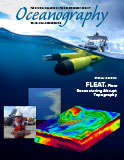Article Abstract
The Republic of Palau, a group of islands in the western tropical Pacific Ocean, is located between the westward-flowing North Equatorial Current (NEC) to the north and the eastward-flowing North Equatorial Countercurrent (NECC) to the south, and the Mindanao Eddy (ME) lies to the west. This unique geographical location may make Palau an oceanographically sensitive region due to strong equatorial zonal flows encountering steep island topography. We investigate the effect Palau has on the regional ocean circulation through numerical model simulations with identical forcing but differing bathymetry: one with Palau and the other without it. The simulations use realistic initial conditions—monthly climatological atmospheric forcing, open-ocean boundary conditions, and runoff fluxes—and were run for up to 37 years to distinguish between model intrinsic variability and deterministic differences. The significant differences between the two solutions show that Palau’s effect on circulation is localized and small. The model state differences, quantified as percentage of model variability near Palau from the 37-year solution, are about 20% for sea surface height, 25% for surface velocities, and <1% for surface temperature and salinity. The subsurface velocity fields around Palau show a two-layered flow, as previously reported by other authors, with upper layer flow from the surface to 300 m, and a lower layer flow from 300 m to 3,000 m. The topographic form stress on Palau is <10% of the vertically integrated total form stress in the 5°N–10°N latitudinal band, and when the island is removed from model simulations, the stress is redistributed within the region. Although these results are restricted to model resolution scales and physics, they provide an estimate of the influence of Palau on the large-scale northwestern tropical Pacific Ocean circulation.

